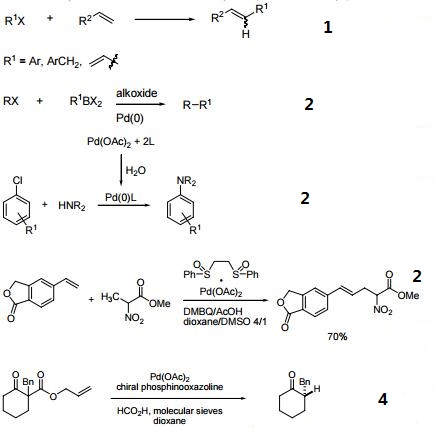Home >> Product >> Noble metals >> Palladium (II) Acetate
- Product Name: Palladium (II) Acetate
- Synonyms: ACETIC ACID PALLADIUM(II) SALT;PALLADIUM ACETATE;PALLADIUM(+2)ACETATE;PALLADIUM DIACETATE;PALLADIUM(II) ACETATE
- CAS No.: 3375-31-3
- Molecular Formula: C4H6O4Pd
- Molecular Weight : 224.51
- Specification : 98%
- Place of Origin: China
- Appearance :
- Document : Download
Description of Palladium (II) Acetate
| Palladium (II) Acetate Chemical Properties | |
| Melting point | 205 °C |
| storage temp. | Store at R.T. |
| solubility | Soluble as monomer in glacial acetic acid or as trimer in benzene. |
| form | Various Forms In Red-(Powder/Flake/Crystalline/Beads) |
| color | Red-brown |
| PH | 2-3 (H2O, 20℃)(aqueous suspension) |
| Water Solubility | insoluble |
| Sensitive | Hygroscopic |
| λmax | 400nm(EtOH)(lit.) |
| Merck | 14,6991 |
| InChIKey | PCUVQHHZCJMCHO-UHFFFAOYSA-M |
| CAS DataBase Reference | 3375-31-3(CAS DataBase Reference) |
| EPA Substance Registry System | Acetic acid, palladium(2+) salt(3375-31-3) |
| Safety Information | |
| Hazard Codes | Xi,Xn,C |
| Risk Statements | 41-36/37/38-40-35 |
| Safety Statements | 26-39-36/37/39-45-36 |
| RIDADR | 3261 |
| WGK Germany | 2 |
| RTECS | AJ1900000 |
| F | 10-23 |
| TSCA | Yes |
| HS Code | 28439090 |
| Palladium (II) Acetate Usage And Synthesis | |
| Reactions |
 |
| Chemical Properties | brown needles |
| Uses | suzuki reaction |
| Uses | Palladium (II) Acetate Trimer is used in Suzuki-Miyaura cross-coupling reactions. It also serves to catalyze the chemoselective reduction of nitroarenes. |
| Uses | A catalyst for intramolecular coupling. |
| Purification Methods | It recrystallises from CHCl3 as purple crystals. It can be washed with AcOH and H2O and dried in air. Large crystals are obtained by dissolving it in *C6H6, adding half its volume of AcOH and allowing it to evaporate slowly at room temperature. It forms green adducts with nitrogen donors, it dissolves in KI solution to form solid PdI2 and a red solution of PdI42-, but is insoluble in aqueous saturated NaCl, and NaOAc. It dissolves in HCl to form PdCl42-. It is soluble in CHCl3, CH2Cl2, Me2CO, MeCN, Et2O, but it is insoluble in H2O, and decomposes when warmed in alcohols in which it is also insoluble. [Morehouse et al. Chem Ind (London) 544 1964, Stephenson et al. J Chem Soc 3632 1965, Skapski & Smart J Chem Soc (D) 658 1970, Heck Acc Chem Res 12 146 1979.] |
| Palladium (II) Acetate Preparation Products And Raw materials | |
| Preparation Products | (S)-(-)-7,7'-BIS[DI(3,5-DIMETHYLPHENYL)PHOSPHINO]-2,2',3,3'-TETRAHYDRO-1,1'-SPIROBIINDANE-->(R)-7,7'-BIS(DIPHENYLPHOSPHINO)-1,1'-SPIROBIINDANE-->Bergapten-->(R)-(+)-7,7'-BIS(DIPHENYLPHOSPHINO)-2,2',3,3'-TETRAHYDRO-1,1'-SPIROBIINDANE-->(R)-(+)-7,7'-BIS[DI(4-METHYLPHENYL)PHOSPHINO]-2,2',3,3'-TETRAHYDRO-1,1'-SPIROBIINDANE-->(S)-7,7'-Bis[di(p-methylphenyl)phosphino]-1,1'-spirobiindane ,97%-->4-(2-KETO-1-BENZIMIDAZOLINYL)PIPERIDINE-->Diphenylacetylene-->C-(3,4-DIHYDRO-2H-BENZO[1,4]OXAZIN-3-YL)-METHYLAMINE-->Ethyl (R)-2-hydroxy-4-phenylbutyrate-->3-AMINOBIPHENYL-->2,3-DIHYDRO-1H-INDOLE-5-CARBOXYLIC ACID-->5-CYANO-2,3-DIHYDRO-1H-INDOLE-->INDOLINE-6-CARBOXYLIC ACID-->ethyl indoline-6-carboxylate-->3-PHENYLBENZYLAMINE-->1-(4-Pyridyl)piperazine-->4,6-Diamino-2-pyrimidinol-->2-MORPHOLINO-5-(TRIFLUOROMETHYL)BENZALDEHYDE-->ethyl 1H-indole-6-carboxylate-->4-AMINOBIPHENYL-->N,N'-Bis- (1-naphthalenyl)-N,N'-bis-phenyl-(1,1'-biphenyl)-4,4'-diamine-->1-ACETYL-5-AMINO-2,3-DIHYDRO-(1H)-INDOLE-->5-Phenylthiophene-2-carboxylic acid-->5-PHENYL-2-THIOPHENECARBALDEHYDE-->(E)-METHYL 3-(4-BROMOPHENYL)ACRYLATE-->4-Aminophenylboronic acid pinacol ester-->5-Methylindole-->3-Phenyl-1H-pyrazole-->Allyl acetate |
| Raw materials | Acetic acid glacial-->Hydrazine hydrate-->Palladium chloride-->Sodium formate |
Please leave your message to us :
( Your Information is an important part of our business,and we will not share or sell any of it to anyone.)
Products
Contact Us
- Email: info@vosunbio.com
- Tel:+86-512-66566131,89888618
- sales extension 8002

